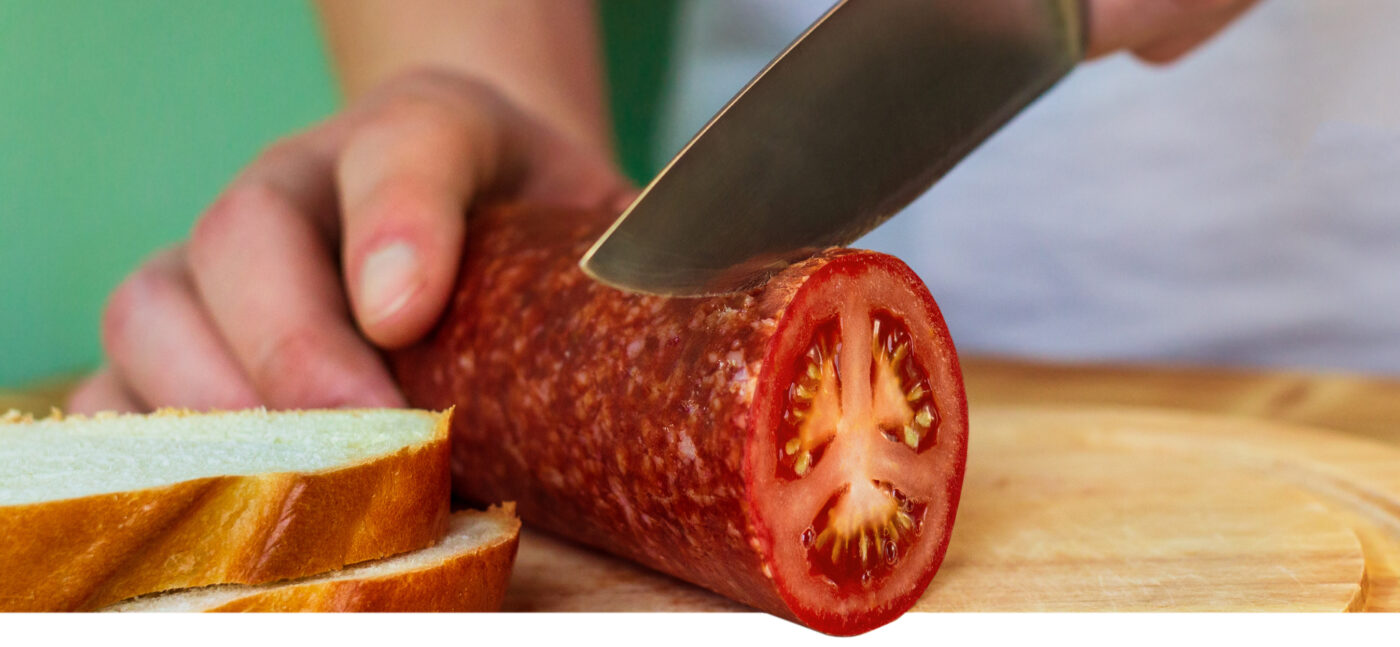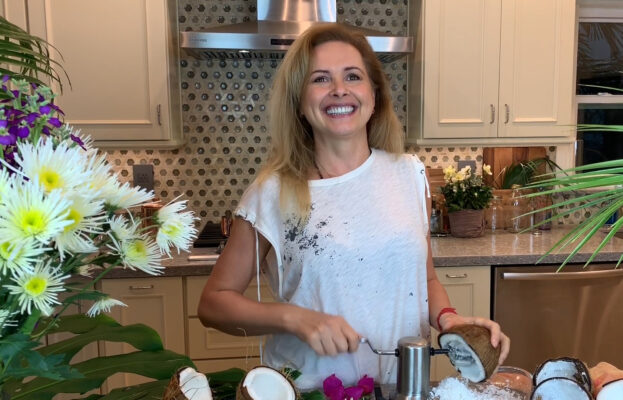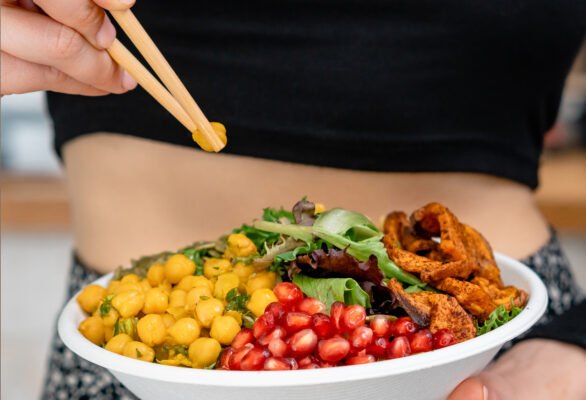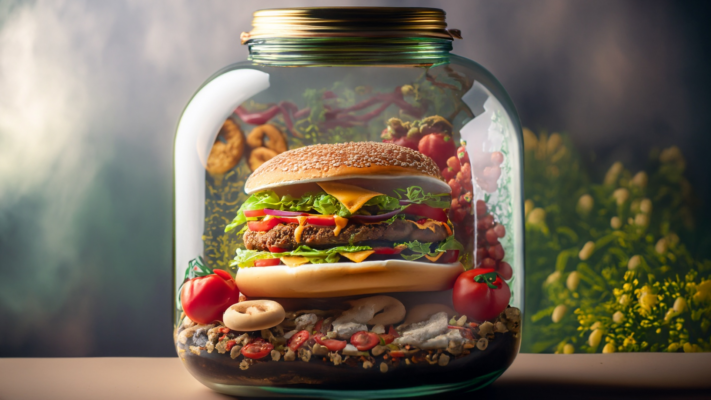Understanding Mindful Substitution: Cutting the Confusion
You might be thinking, “Hold on! Are you saying I can’t have my beloved cheesecake ever again?” Well, not quite, my friend. Think of mindful substitution as your chatty mate who always has a cool hack for everything. It’s not about completely banning the cheesecake, it’s about finding the healthiest way to have your cake and eat it too!
Well, let’s venture into the often-chaotic but occasionally harmonious realm of the human mind. Specifically, we’re zeroing in on the parliament of voices that vie for attention when it comes to our food choices. And we’re not talking about your mother-in-law’s advice, your partner’s side-eye at your dinner plate, or even your Fitbit’s passive-aggressive nudges. Nope. We’re dealing with the real bigwigs – the ones inside your own head!
The theater of the human mind is often a chaotic spectacle, especially when it comes to making food choices. And the characters influencing these decisions are the ones that reside inside your own head! The child-like voice demanding an immediate ice cream fix, the disciplinarian reminding you of your weight loss goals, and of course, the negotiator trying to compromise between the two.
Navigating these voices can feel like taming a band of unruly kids without resorting to muting them or succumbing to their every whim. The key to handling this chaos is the art of mindful substitution. Think of it as a peace offering to each voice, addressing their legitimate concerns without letting any of them hijack the conversation. Mindful substitution is not about repression or indulgence; it’s about negotiation and balance.
I’m not implying to swap your grandma’s secret mac and cheese recipe with kale. (Imagine the horror!) I’m talking about small changes, like maybe using whole-grain pasta instead of white or adding in some veggies for that extra richness, texture, and color.

Nibbling on Wisdom: The Sweet Savvy of Mindful Substitution
Here’s the thing: mindful substitution isn’t just about swapping your guilty pleasures with healthier alternatives. It’s about understanding your cravings and exploring creative ways to satisfy them without setting off alarm bells in your body. It’s like being a foodie artist, painting a healthier lifestyle with different flavors and textures.
The real fun kicks in when you start experimenting. Imagine being a contestant on your personal Masterchef. You’ve got an array of ingredients, a hungry stomach, and a bustling mind full of crazy foodie ideas. And the best part? There are no Gordon Ramsays to intimidate you. Your kitchen, your rules!
It’s like a foodie treasure hunt. You might end up discovering some delicious alternatives that you wouldn’t have otherwise tried. Ever thought of swapping those sugar-loaded chocolate chip cookies with ones made from oatmeal, raisins, and cacao nibs? Or replacing the greasy potato chips with some crunchy roasted chickpeas?
In practice, mindful substitution could take many forms. Someone might have a thing for the fizz and sweetness of soda. They’re aware of the downside to this sugary treat but also can’t completely let go. So, they switch to sparkling water with a dash of fruit juice. The fizz is there, a hint of sweetness too, but the harmful sugar is considerably reduced.

The beauty of mindful substitution lies in the fact that it doesn’t advocate deprivation. Rather, it creates room for healthier choices by redefining how we perceive rewards and how we satiate cravings.
For my friend Mike, a day without chocolate is like a day without oxygen. But even he acknowledges that making daily love to chocolate bars won’t score him any sweet points with his waistline or his doctor. His winning strategy? He indulges in a lusciously juicy date, stuffed to the brim with roasted walnut, and sprinkled liberally with raw cacao nibs. He swears it’s better than the most luxurious dessert on the planet. What’s more, he swears he doesn’t miss his old chocolate bars one bit. He adds raw cacao nibs to the berries and fruits as well. You see, he still basks in the ecstasy of chocolate, but in a way that tips his hat to both his sweet tooth and his health.
So the next time your inner child kicks up a fuss for a sweet treat, remind yourself that negotiation is always an option. It might take a bit of creativity, experimentation, and resilience, but isn’t that what life is about?
In the past, I indulged in a frosty bowl of ice cream way too much. But one day, I dared to swap my cherished creaminess for a bowl of frozen mango slices. Lo and behold! The sweet, frost-kissed fruit soothed my longing for ice cream. I didn’t stop there, though. I transformed into a fruit alchemist, merging various frozen fruits and berries to summon forth scrumptious homemade “ice cream” on a whim. Now, I’m as blissful as a kid with a sundae, and my body thanks me for the vitamin-infused treats.
When that inner sweet tooth starts acting up, you might need some clever distractions. Let’s say you’re craving something sweet. Instead of reaching for that chocolate bar, how about grabbing a piece of fruit, a yogurt, or a homemade smoothie? Or even better, trick that sneaky sweet tooth with some strong flavors like mint, sauerkraut or chili. It’s sour, it’s intense, and oddly enough, it curbs the desire for sweets. Weird? Maybe. Effective? Absolutely!
Heart-to-heart with your Cravings
We don’t need to be dictators or pushovers when it comes to our inner voices. We can listen, acknowledge, negotiate, and compromise. We can steer our way through the choppy seas of desires, habits, and impulses. We might wobble a bit, like a newbie surfer riding their first wave, but that’s part of the journey, isn’t it?
The best part about mindful substitution? It gives you a chance to truly understand your cravings, to have a heart-to-heart chat with them. What is it you’re really craving? Is it the creamy sweetness of ice cream or the cold relief on a hot summer’s day? Is it the crunch of the chips or the simple act of munching while binge-watching your favorite show?
Once you start decoding your cravings, you’ll have a secret superpower to not only satisfy them but also keep things healthy. It’s like a cheat code to guilt-free indulgence!
Mindful substitution isn’t about deprivation. It’s about creating space for better choices. It’s about redefining what we perceive as rewards and how we choose to satisfy our cravings.
Keep in mind; we’re not trying to win a war against our desires; we’re not at war with them at all. We’re aiming for a mutual understanding. It’s about telling our inner voices, “I hear you, I understand you, and I’m not here to suppress or indulge you but to find a balance.”
The beauty of mindful substitution lies in its flexibility. It’s not a rigid diet plan but a fun, exploratory journey. It’s a personal challenge, a puzzle to solve, and in the process, you learn so much about yourself, your habits, and your preferences. So, embrace the missteps, applaud your victories, and remember to keep things light and fun.

Dancing with Desire: The Twist and Shout of Mindful Substitution
Let’s delve into the science that makes mindful substitution such a gem. At its core, this practice is about psychology, and as any good magician (or cognitive psychologist) will tell you, our brains love a good trick.
Mindful substitution is akin to a sleight of hand, a benevolent illusion where we convince our brains that we’ve given it what it wanted, even when we’ve swapped the desired item for a healthier alternative. But it’s not about deception. It’s about reframing our relationship with food and learning that healthful choices can be just as satisfying as less healthful ones.
Take, for instance, Larry, a friend of mine, a coffee aficionado and self-proclaimed caffeine addict. Larry’s day didn’t officially start until he’d had his venti triple-shot caramel latte. As delicious as it was, it was also a sugar bomb waiting to explode in his bloodstream. Realizing this, Larry decided to swap his sugary latte for black coffee with a dash of milk and a sprinkle of cinnamon. It wasn’t an instant switch, he said, but Larry persevered. And voila! After a while, he found himself enjoying his new coffee routine. Plus, the cinnamon gave him an unexpected perk – it helped regulate his blood sugar!
But mindful substitution is not just about your physical health; it can be a tool for mindfulness and even mental well-being. As you practice mindful substitution, you’re also cultivating a deeper awareness of your habits, preferences, and patterns. You start to notice your triggers, your weak moments, your strengths, and your victories. It’s like turning a lens onto your relationship with food. That, in itself, can be transformative.

You see, once we understand our tendencies, we can make more informed choices that serve us better in the long run. We’re not just mindlessly reaching for that bag of chips or that bar of chocolate. We’re choosing to engage with our food, our cravings, and ultimately, with ourselves. And this sense of engagement can permeate other areas of our life, promoting overall well-being.
Consider Natalie (my friend from Ukraine), a self-confessed stress eater. Whenever work got too intense, she’d find solace in a box of cookies. But once she started practicing mindful substitution, she didn’t just swap her cookies for carrot sticks. She began to notice her stress patterns, her triggers, and she started substituting her stress-eating with deep breathing exercises. Natalie is not just a mindful substitution success story, she’s a testament to the deeper change this practice can bring about.

Taming the Temptation Beast
Mindful substitution is an exploration. It’s not about getting it right every single time or never having that piece of cake or that bucket of fried chicken. It’s about finding your balance, knowing that it’s okay to indulge sometimes, and learning how to make better choices most of the time. And who knows, in this playful exploration, you might stumble upon delicious foods and flavors that you’d never considered before.
So, as you sip on your vegetable smoothie (that you initially wished was a soda) or bite into your wholegrain toast (that you dreamt was a donut), remember – it’s not just about what you’re eating, it’s about what you’re becoming – more aware, more balanced, and perhaps, a tad bit wiser.
In fact, this process of mindful substitution can be likened to a conversation with oneself. To me it’s about pausing, asking myself, “Is this what I truly want? Is this what my body needs?” Instead of automatically reaching for my usual comfort foods, I’m taking a moment to listen to my body, honor its needs, and respect its limits.
Mindful substitution isn’t just a crafty strategy, it’s also an exercise in mindfulness and even emotional wellness. When we practice this technique, we’re not just replacing one food with another. We’re starting to pay attention to our habits, likes, and patterns. We begin to recognize our triggers and our strengths. It’s like shining a spotlight on our relationship with food, which in itself can be quite transformative.
Once we understand our tendencies, we’re in a better position to make more informed decisions that benefit us in the long run. Instead of mindlessly reaching for that bag of chips or that bar of chocolate, we’re consciously choosing to interact with our food, our cravings, and ultimately, with ourselves. This sense of involvement can extend into other areas of our lives, enhancing our overall well-being.
Take, for instance, the case of a typical workaholic. Their hectic schedule often leads to stress eating. When the pressure builds up, they often find solace in comfort food. But when they start using mindful substitution, the shift isn’t just in their diet. They begin to understand their stress patterns, their triggers, and start replacing stress-eating with more beneficial techniques, like deep breathing or a quick stretch. It’s not just a tale of dietary transformation, it’s an account of the profound changes this practice can stimulate.

Dodging Diet Drama: The Art of Stumbling Through Mindful Substitution
Let’s be real here. Not every substitute is going to be a slam dunk. Some might be a complete swing-and-a-miss. You might swap your soda for a homemade lemonade, only to find it tasting like sour fizzy water, or try to replace your midnight cookie binge with a bowl of fruit and end up feeling unsatisfied.
And guess what? That’s okay! We are not after perfection here. We’re simply looking to make a series of small changes that will add up over time. After all, every stumble, every ‘whoops’, gets us closer to a ‘eureka!’ moment.
But here’s the most crucial aspect of mindful substitution – it’s not about perfection. It’s about progression. There will be days when we might still reach out for that doughnut instead of an apple, days when we might skip our workout for a TV binge. And that’s okay. We’re humans, after all, not programmed bots.
What matters is our ability to get back on track, to not let a day’s lapse become a reason for completely giving up on our healthier habits. It’s about being kind to ourselves, about understanding that it’s okay to enjoy our favorite foods occasionally, and about knowing that our worth is not dictated by the perfection of our diet.
Mindful substitution is more than just a dietary tactic. It’s a lifestyle strategy, a philosophy that encourages us to be present, aware, and compassionate toward ourselves. It gives us the tools to navigate our complex relationship with food, enabling us to strike a balance that respects our health and our pleasure.
The beauty of mindful substitution lies in its flexibility. It’s not a rigid diet plan but a fun, exploratory journey. It’s a personal challenge, a puzzle to solve, and in the process, you learn so much about yourself, your habits, and your preferences. So, embrace the missteps, applaud your victories, and remember to keep things light and fun.
And let’s raise a toast (preferably whole-grain, lightly buttered) to mindful substitution, to wobbly balance, and to the exhilarating roller-coaster ride that is mindful eating! Here’s to our journey toward turning the tables on our temptations with compassion and wisdom. Here’s to finding joy and health, not in perfection, but in our beautifully imperfect progress.
PRACTICES

The Mindful Swap Experiment
- Mindful Shopping: On your next grocery trip, make it a point to hunt for a healthy, yet enticing substitute for one of your go-to treats. This could be anything – from fresh, exotic fruits for your sweet tooth, whole grain crackers with an interesting flavor for your salty cravings, or sparkling water with a twist of lime for your soda urges.
- Preparation Party: Once you bring your chosen substitute home, don’t just toss it into the fridge and forget about it. Make the preparation a ritual. Serve it up on your favorite dish, garnish it, make it look Instagram-worthy! The more attractive your treat looks, the more you’ll look forward to savoring it.
- Assess Your Hungers: Now, before you take your first bite, pause. Tap into your Nine Hungers. What’s your physical hunger level like? What’s your heart hungering for? Is your mind hungering for distraction or comfort? This initial assessment will give you a clearer picture of what you’re truly craving.
- Savor Slowly: This is where the magic happens. As you start eating your treat, go slow. Switch off the TV, close that book, and direct all your attention to the food in front of you. Tune into the texture, the flavor, the aroma, the temperature. Savor every mouthful.
- Post-Treat Reflection: Once you’ve finished your treat, pause again. Revisit your Nine Hungers. Has your physical hunger been satisfied? How about your heart and mind hunger? Has the substitute treat satiated your cravings? Also, reflect on your overall satisfaction levels – do you feel deprived, or pleasantly surprised?
- Sharing is Caring: If you’re a part of a mindful eating group or if you have friends who are also trying to eat healthier, share your experience. Discuss the substitutes that worked for you, the ones that didn’t, and listen to others’ experiences. This exchange of ideas can be an immense source of support and inspiration.
Keep in mind; this is not a test; it’s an experiment. There are no right or wrong answers here. It’s all about exploring, observing, and discovering what works for you. So, embrace the challenge with an open mind and a playful spirit, and let the mindful substitutions begin!
Be Alive 🌱
Love ❤️, Julia
Mindful Eating 🥢
Mindful Eating Meditation
GUIDED MEDITATIONS 💗
DISCLAIMER: The materials and the information contained on the Positive Pranic website are provided for general and educational purposes only and do not constitute any legal, medical, or other professional advice on any subject matter. None of the information on our videos is a substitute for a diagnosis and treatment by your health professional. Always seek the advice of your physician or other qualified health providers prior to starting any new diet or treatment and with any questions you may have regarding a medical condition. If you have or suspect that you have a medical problem, promptly contact your health care provider.



























